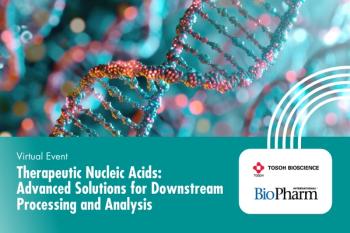
- BioPharm International-01-01-2012
- Volume 25
- Issue 1
Therapeutic Vaccine Outlook
Has an approval in oncology reignited interest in the recruitment of the immune system in the fight against disease?
Therapeutic vaccines work on the premise that the immune system can be trained or optimized to take action against elements of a diseased state or condition already present in an individual. However, perhaps because of the immune system’s complexity and incomplete knowledge of its pathways of action, only a few therapeutic vaccines have been approved to date.
Disease areas most commonly targeted by this immunotherapeutic approach are unsurprisingly those that have proven difficult to treat or cure through other means: AIDS, hepatitis B, and various autoimmune diseases are good examples. However, the use of therapeutic vaccines in oncological indications appears to have garnered the most interest. Researchers in this area found great promise in April 2010, when Dendreon’s Provenge (Sipuleucel-T) became the first therapeutic cancer vaccine to be approved by FDA. Provenge is an autologous cellular immunotherapeutic for the treatment of asymptomatic or minimally symptomatic metastatic hormone refractory prostate cancer. Looking ahead, the market for cancer vaccines certainly has the potential for huge growth, with some reports indicating compound annual growths rates over 100% in the next few years (1).
CANCER VACCINES
Most cancer cells express tumor-associated antigens (TAAs) that can be recognized by the immune system as “foreign” and thus serve as potential targets for cancer vaccines. MART-1, MAGE-3, NY-ESO-1, prostate specific antigen, and prostatic acid phosphatase (PAP) are all examples of TAAs. Cancer vaccines seek to trigger a strong immune response to tumors by introducing TAAs into the patient possibly alongside adjuvants or immunostimulators and tend to fall into two camps. Tumor antigen-based vaccines can use peptides, recombinant proteins, tumor lysates, or killed tumor cells as TAAs. Cell-based vaccines, on the other hand, use ex vivo–prepared TAA-loaded antigen presenting cells (APCs) as the vaccine. In fact, it is the patient’s own APCs that are isolated from peripheral blood cells and loaded with TAAs in cell culture. Often, the precursor monocytes are cultured with cytokines to create dendritic cells (DCs), which are particularly potent APCs. Provenge is an example of this kind of cell-based vaccine; a recombinant antigen—a fusion protein consisting of PAP and the cytokine granulocyte-macrophage colony-stimulating factor (GM–CSF)—is cultured with the patient’s APCs in Dendreon’s manufacturing facility. Once the APCs have matured, they are infused back into the patient.
Looking at a few cancer vaccines in development pipeline, the picture looks quite bright, with tumor-antigen vaccines dominating over cell-based vaccines. Galena Biopharma’s NeuVax (E75) for breast cancer falls into the peptide-based category and has successfully completed a Phase II trial. The E75 peptide is derived from human epidermal growth factor receptor 2 (HER2) and also uses GM–CSF; together they stimulate cytotoxic T cells to target cells expressing any level of HER2. FDA has granted NeuVax a Special Protocol Assessment (SPA) for its Phase III Prevention of Recurrence in Early-Stage, Node-Positive Breast Cancer with Low to Intermediate HER2 Expression with NeuVax Treatment (PRESENT) study, which the company indicates will begin in the first half of 2012. Galena also announced in November 2011, the establishment of a clinical development collaboration with Genentech (a membr of the Roche group) and The Henry M. Jackson Foundation for the Advancement of Military Medicine in which the two companies will sponsor a Phase II clinical study using NeuVax in combination with Genentech/Roche’s Herceptin (trastuzumab). Herceptin, a monoclonal antibody therapy, is currently available for patients with higher levels of HER2 expression.
Antigen Express, a subsidiary of Generex, has a similar product in development for breast cancer that is also a peptide fragment of the HER2 receptor called AE37. This is the company’s first candidate to take advantage of its Ii-Key Hybrid technology platform, which modifies fragments of antigens with the intention of increasing their potency in eliciting an immune response. Antigen Express is conducting a controlled, randomized, and single-blinded Phase II clinical study in HER2 expressing patients with either node positive or high-risk node-negative breast cancer. As with NeuVax, AE37 is administered with GM-CSF. The company released positive interim results for the study in August 2011. As HER2 is expressed in numerous cancer types, it has possibilities beyond breast cancer. Antigen Express has also completed a Phase I trial for prostate cancer.
Big Pharma is also trying to move forward with therapeutic vaccines. MAGE-A3 is currently in Phase III trials for the treatment of melanoma and non-small cell lung cancer (NSCLC) and forms part of GlaxoSmithKline’s antigen-specific cancer immunotherapeutic (ASCI) pipeline. The compound combines purified MAGE-A3 tumor antigen—a protein expressed in a large number of cancers in-licensed from the Ludwig Institute for Cancer Research—with a combination of immunostimulating compounds called AS15. The GSK ASCI pipeline also includes a treatment for acute myelogenous leukaemia at Phase II called WT1 and two other candidates at Phase I, NY-ESO-1 and PRAME.
Beyond vaccine development, GSK has also been working with Abbott Molecular on automated companion diagnostic tests for MAGE-A3 expression since 2009, and in November 2011, expanded the agreement to include the PRAME antigen. The polymerase chain reaction-based tests identify specific DNA sequences to help determine those patients most likely to benefit from the therapy.
Merck Serono is also in the NSCLC space with Stimuvax (BLP25 liposome vaccine), currently in Phase III, which it obtained with worldwide rights for development and commercialization from Oncothyreon. Stimuvax is designed to stimulate the immune system into targeting cells expressing glycoprotein MUC1, which is over-expressed or aberrantly expressed in many types of cancer. NovaRX is another company targeting NSCLC with its lead candidate Lucanix, which is also in Phase III trials that began in 2008. Unlike Stimuvax and MAGE-A3, however, Lucanix is a cell-based therapy that treats patients with four NSCLC cell lines that have been genetically modified to block transforming growth factor-beta. TGF-beta is produced by cancer cells and is thought to exert an immunosuppressive effect thus protecting them from an antitumor response.
A quick search of the National Cancer Institute’s clinical-trial database reveals a large number of potential cancer vaccines currently under development, more than a handful in Phase III. If they follow Provenge’s lead, the market growth predicted could become a reality.
NICHE THERAPIES
Although there is much R&D and, more recently, excitement in cancer vaccines, there are many other areas that could potentially benefit from therapeutic vaccines. ImmusanT (Cambridge, MA), for example, has zeroed in on celiac disease and is developing technology based on research performed at The Walter and Eliza Hall Institute of Medical Research in Melbourne, Australia, and at the University of Oxford, UK. NexVax2 is a combination of three short peptides from gluten protein that have been shown to cause an immune reaction in the 90% of sufferers with the HLA DQ2 gene, according to company information. NexVax2 is a peptide-based vaccine, but the aim, rather than increasing the immune response, is to desensitize its reaction to gluten. NexVax2 is progressing through to Phase II clinical trials.
The development of therapeutic vaccines as a new approach to combat substance abuse is another potential area for growth. Nicotine and cocaine are both examples of drug targets under development. The concept of long-lasting single injections, for example, removes the hurdle of the reliance on behavioral modification to control the intake of substances with the potential for addiction. Nicotine vaccines are designed to induce production of antibodies that bind to nicotine in the blood creating a molecule that is too large to cross the blood-brain barrier and thus cause pleasurable effect. However, Nabi Biopharmaceuticals announced on Nov. 7, 2011, results from its second Phase III trial for NicVax (Nicotine Conjugate Immunotherapeutic) and, unfortunately, preliminary assessment of the data showed that the primary endpoint was not met and there was no statistical difference between the NicVAX and placebo groups—these results are similar to the first Phase III study. Cytos Biotechnology and Novartis’ collaboration on NIC002, another compound designed to induce nicotine antibodies, also failed to demonstrate efficacy in Phase II trials after interim analysis.
Despite these failures, the market for antismoking products will no doubt continue to drive research into vaccines against nicotine addiction. As with other therapeutic vaccines under development, proving efficacy will remain a key challenge.
REFERENCE
1. BCC Research, Therapeutic Vaccines: The Global Market, Report BIO052B (2010).
Articles in this issue
almost 14 years ago
BioPharm International, January 2012 Issue (PDF)almost 14 years ago
Auditing by the Numbersalmost 14 years ago
Here's to a Year of Compromisealmost 14 years ago
USAID Moves Global Healthcare Initiatives Forwardalmost 14 years ago
Budget Crunch, Political Battles Shape Policy Agenda for Yearalmost 14 years ago
A 25-Year Retrospective on Separations Technologyalmost 14 years ago
An Overview of Risk Assessment Strategies for Extractables and Leachablesalmost 14 years ago
Global Economic Woes Overshadow Biotech Industry Advances in 2011Newsletter
Stay at the forefront of biopharmaceutical innovation—subscribe to BioPharm International for expert insights on drug development, manufacturing, compliance, and more.




